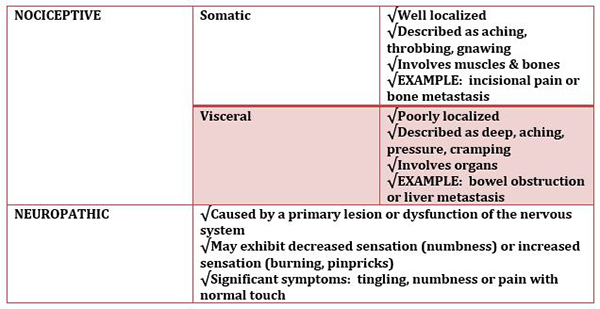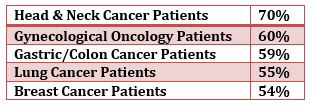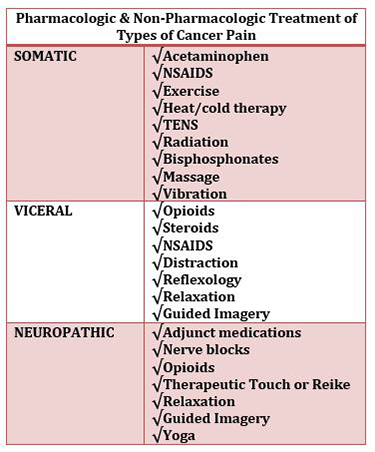Optimizing Rehabilitation in Cancer Patients with Pain
Maureen Musto, MS APRN-CNS ACNS-BC CRRN
Lisa Blackburn, MS APRN-CNS AOCNS, Pain Clinical Nurse Specialist
Oncology rehabilitation is becoming relatively common in rehabilitation centers. Rehabilitation care can decrease suffering and improve quality of life. Pain is often a barrier to attaining the patient’s rehabilitation goals. To enhance the quality of cancer rehabilitation it is imperative to have a basic understanding of types of pain and treatment options.
Many cancer patients experience both acute and chronic pain during their disease and treatment experience. It is helpful to know the differences between the two:
Autonomic adaptation occurs because the neurologic system adapts to the constant pain input over a long period of time. This adaptation will be seen by the nurse as a patient who still reports high pain levels, but does NOT exhibit symptoms of crying, grimacing, guarding, and VS changes. Another consideration in cancer patients is whether they are experiencing nociceptive versus neuropathic pain:

It is important to note that some cancer diagnoses come with greater levels of pain than others. Studies have shown that patients with the following cancer diagnoses report the highest incidence of pain:

In general, one in three cancer patients experience some pain during their disease trajectory.
As with other patients in pain, specific types of cancer pain respond to specific pharmacologic and non-pharmacologic interventions. The table below outlines some great options to utilize during rehabilitation of cancer patients:

To adequately care for patients with cancer pain, the cancer pain needs to be identified, assessed, classified, and managed with a multistep approach (Ripamonti & Bossi, 2014). The rehabilitation setting offers an ideal place in that the interdisciplinary team addresses not only the pain but the functional ability of the patient. Therapy treatments, such as strengthening, stretching, warm/cold therapies and use of assistive devices, used as adjunctive treatments or replacements to medications provide a comprehensive plan. Rehabilitation nurses provide a vital role in implementation of the patient’s individualized plan around the clock, as well as, being skilled at monitoring pain and communicating both the effectiveness and ineffectiveness of interventions, to the team. Effective pain management requires diligent monitoring and adjustment. Patients with cancer benefit from this comprehensive care that is provided by intense rehabilitation.
REFERENCES:
Czarnecki, M.L. & Turner, H.N. (2018). Core curriculum for pain management nursing (3rd ed.). St. Louis, Missouri: Elsevier.
Heywood, R., McCarthy, A.L., Skinner, T.L. (2018). Efficacy of exercise interventions in patients with advanced cancer: A systematic review. Archives of Physical Medicine & Rehabilitation, 99(12), 2595-2620.
Morgan, D.D., Marston, C., Garner, J., Currow, D.C. (2018). Subacute rehabilitation does have benefits for patients with advanced cancer. Journal of Pain and Symptom Management, 55(1), e1-e2.
Pasero, C. & McCaffery, M. (2011). Pain assessment and pharmacologic management. St. Louis: Elsevier.
Ripamonti, C.I., & Bossi, P. (2014). Cancer Pain. In Rehabilitation Issues during Cancer Treatment and Follow-Up (pp. 11-36). European Society for Medical Oncology Handbook Series.

